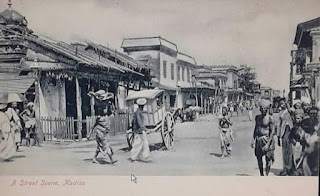Black Town Madras in 1748
A description of the Black Town, Madras and the Devadasis of Temples in 1748 AD in London Magazine
In the Black Town the streets are much more numerous and more spacious than those of the White Town, with this further advantage that some of them are planted with trees; but the houses are not near so good. Some few of them are built with brick but the rest are wretched cottages with walls of clay and thatched with Palmetta leaves. According to the East India manner they have no windows on the outside but are all built around a courtyard from whence only they have Light, and none of them have any furniture within, but the Mats and Carpets the people lie on with a few utensils. This they need not give themselves much trouble about for a stranger seldom comes any farther than the Door before which is erected a little shade supported by pillars (Thinnai) where they sit cross legged morning and evening to receive visitors and transact business.
In this town likewise there are some public buildings which make a tolerable figure such as the Armenian Church, and several Pagodas or Indian Temples to the latter of which besides their priests belong great number of female Choristers or singing women. They are like Nuns, are in their youth devoted to the service of the Temple and the Priests and spend some part of their time in singing anthems to their idols; but as they are not locked up, they spend the rest with gallants of all Religions and Nations. They likewise serve the public in another capacity; for when any great Man or rich Merchant goes abroad he has a number of these girls who run singing before him; and even some of our Governor have made use of this piece of Grandeur having kept 50 of these girls for this purpose.
In the Black Town the streets are much more numerous and more spacious than those of the White Town, with this further advantage that some of them are planted with trees; but the houses are not near so good. Some few of them are built with brick but the rest are wretched cottages with walls of clay and thatched with Palmetta leaves. According to the East India manner they have no windows on the outside but are all built around a courtyard from whence only they have Light, and none of them have any furniture within, but the Mats and Carpets the people lie on with a few utensils. This they need not give themselves much trouble about for a stranger seldom comes any farther than the Door before which is erected a little shade supported by pillars (Thinnai) where they sit cross legged morning and evening to receive visitors and transact business.
In this town likewise there are some public buildings which make a tolerable figure such as the Armenian Church, and several Pagodas or Indian Temples to the latter of which besides their priests belong great number of female Choristers or singing women. They are like Nuns, are in their youth devoted to the service of the Temple and the Priests and spend some part of their time in singing anthems to their idols; but as they are not locked up, they spend the rest with gallants of all Religions and Nations. They likewise serve the public in another capacity; for when any great Man or rich Merchant goes abroad he has a number of these girls who run singing before him; and even some of our Governor have made use of this piece of Grandeur having kept 50 of these girls for this purpose.




Comments